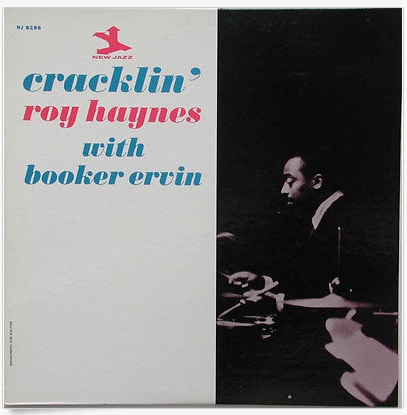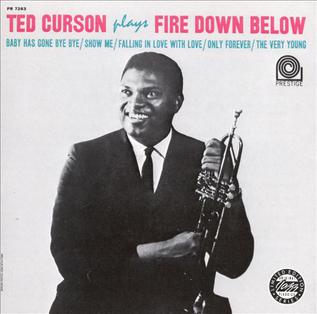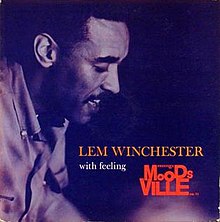LISTEN TO ONE: I Wonder
I love it that Jimmy Witherspoon starts off this set with "I Wonder." This song, written and originally performed by Cecil Gant, is frequently credited with being the first rhythm and blues hit. Gant recorded it in 1944, first for the tiny Black-owned Bronze label, and then, as it started to catch with another small but not quite so small label, the whine-owned Gilt Edge, with better chances at distribution. Appealing to WWII patriotism, Gant is "Pvt. Cecil Gant" on the label, and that underscored the poignancy of the song, with its lyric that suggested a lonely GI wondering if his girl friend back home was with another man. But "I Wonder" didn't need anything but itself. It was a winner, a beautiful blues ballad with Gant accompanying himself on the piano.
Nothing's ever entirely new, and Gant's soft, sensitive approach to the blues had been pioneered in the 1920s by Leroy Carr. But "I Wonder" ushered in a new era and a new sound--a sound that was so new it didn't have name in 1944, so when the record went to the top of the Billboard charts, the chart was the Harlem Hit Parade. It did not become rhythm and blues till 1949.
Gant's record was a hit, but "I Wonder," the song, was huge. Roosevelt Sykes recorded it for Bluebird, and with Sykes's popularity and RCA Victor's distribution, he had a Number One hit. And in an unusual moment in chart history, the record it replaced at Number One was Pvt. Cecil Gant's version of "I Wonder." Louis Armstrong recorded a gorgeous version of it in 1945, with the song giving Armstrong a vehicle for one of his most poignant and sensitive vocals. His recording went to number three on the charts, and "I Wonder" has been a staple ever since, right down to a recent duet by Tony Bennett and k. d. lang. We've heard an earlier version of the song on Prestige, by Etta Jones.
"I Wonder" represented a new era in music in more ways than one. The post-WWII manufacturing boom extended to record pressing plants, and small independent labels--the labels that pioneered rhythm and blues and modern jazz--had the ability, for the first time, to get records made on a large scale. And Gant's smooth, blues-inflected crooning style caught on. Rhythm and blues was a big umbrella, encompassing the raucous jump blues of Louis Jordan, the Delta-goes-electric of Muddy Waters, the New Orleans horns behind Fats Domino, Lloyd Price and Little Richard, but the crooning ballad style of Cecil Gant gave birth to a whole generation who came to be known as the "sepia Sinatras." Billy Eckstine and Nat "King" Cole were the mega-stars of this new style, but there were so many others, Sonny Til and Clyde McPhatter and Tony Williams and all the other wonderful voices who created the street corner harmonies known as doowop, on to Johnny Mathis and Sam Cooke.
To make a great record of "I Wonder," all you have to do is sing it, and let its magic come through you. That's exactly what Jimmy Witherspoon does, Ozzie Cadena has given him some extraordinary musicians to back him on this session, and they do their job too.
And, of course, 'Spoon doesn't stop there. Ever the aggregator of wonderful material, he does it again here. "Nobody Knows You When You're Down and Out" was written in 1923 by Jimmie Cox, made unforgettable in 1929 by Bessie Smith, and became an anthem for the Depression. But its lyrics have resonated beyond its time. Again, as with "I Wonder," as is his approach, Witherspoon respects the song, and lets it express itself as only he can.
I won't go through the whole album, but the selections are eclectic and rewarding. One, "Blues in the Morning," is credited to Kenny Burrell, and features some wonderful playing by Burrell, Gildo Mahomes and Roy Haynes.
The Prestige release is entitled Blue Spoon.

:format(webp):mode_rgb():quality(90)/discogs-images/R-2431594-1454093682-2086.jpeg.jpg)

:format(jpeg):mode_rgb():quality(90)/discogs-images/R-6670246-1486744399-7428.jpeg.jpg)










:format(jpeg):mode_rgb():quality(40)/discogs-images/R-14611341-1578155772-8073.jpeg.jpg)














:format(jpeg):mode_rgb():quality(90)/discogs-images/R-3422279-1417632729-4514.jpeg.jpg)


:format(jpeg):mode_rgb():quality(90)/discogs-images/R-11984272-1525996627-6907.jpeg.jpg)